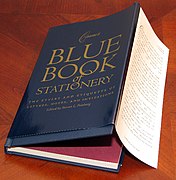Hardcover

A hardcover, hard cover, or hardback (also known as hardbound, and sometimes as case-bound)
Overview
Hardcover books are often printed on acid-free paper, and they are much more durable than paperbacks, which have flexible, easily damaged paper covers. Hardcover books are marginally more costly to manufacture. Hardcovers are frequently protected by artistic dust jackets, but a "jacketless" alternative has increased in popularity: these "paper-over-board" or "jacketless" hardcover bindings forgo the dust jacket in favor of printing the cover design directly onto the board binding. [1][2]
Marketing
If brisk sales are anticipated, a hardcover edition of a book is typically released first, followed by a "trade"
Prices
Hardcover books are usually sold at higher prices than comparable paperbacks. Books for the general public are usually printed in hardback only for authors who are expected to be successful, or as a precursor to the paperback to predict sale levels; however, many
Usual structure
Hardcovers usually consist of a page block, two boards, and a cloth or heavy paper covering. The pages are sewn together and glued onto a flexible spine between the boards, and it too is covered by the cloth. A paper wrapper, or dust jacket, is usually put over the binding, folding over each horizontal end of the boards. Dust jackets serve to protect the underlying cover from wear. On the folded part, or flap, over the front cover is generally a blurb, or a summary of the book. The back flap is where the biography of the author can be found. Reviews are often placed on the back of the jacket. Many modern bestselling hardcover books use a partial cloth cover, with a cloth-covered board on the spine only, and only boards covering the rest of the book.
Gallery
-
Old hardcover books at theMerton Collegelibrary
-
Dust jacket on a hardcover book
-
A King James Bible bound in blue faux-leather cloth
-
Hardbound book with half leather binding (spine and corners) and marbled boards
-
Contemporary hardcover, with partial cloth cover, on the spine only, and boards for the rest
See also
- Book size
- Softcover
References
- ^ Post, Chad W. (2009-06-22). "In Praise of Paper-Over-Board - Publishing Perspectives". Publishing Perspectives. Retrieved 2013-05-07.
- ^ Neyfakh, Leon (2009-08-24). "The New Thing: Books Without Jackets". Observer. Retrieved 2013-05-07.
- ISSN 0362-4331. Retrieved 14 May 2011.
- ^ "The Early Fiction of Gore Vidal: 1946-1956". Archived from the original on 2016-03-03. Retrieved 2017-05-14.





